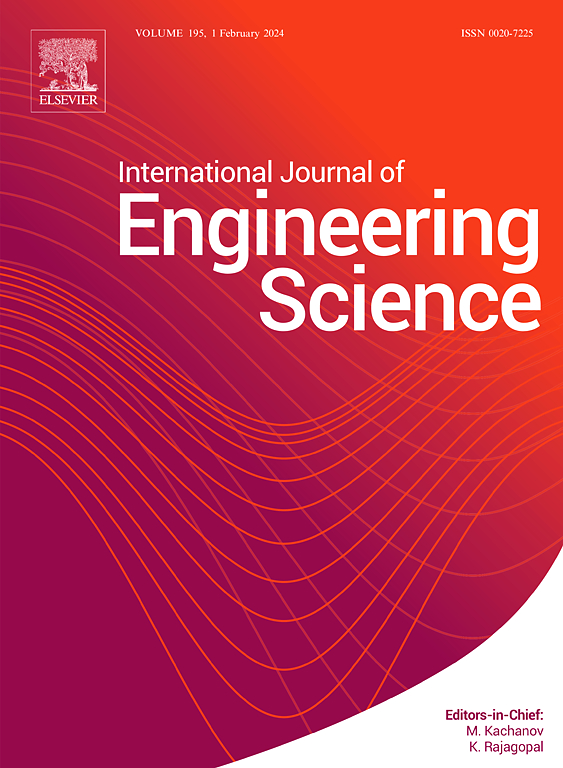A spatiotemporally-nonlocal strain gradient theory for interpenetrating transient polymer networks
IF 5.7
1区 工程技术
Q1 ENGINEERING, MULTIDISCIPLINARY
International Journal of Engineering Science
Pub Date : 2025-07-02
DOI:10.1016/j.ijengsci.2025.104335
引用次数: 0
Abstract
Interpenetrating transient polymer networks having molecular intermixing can provide excellent mechanical performance and damping properties. In this paper, a new physics-based nonlocal strain gradient theory is proposed within the framework of thermodynamics to capture the microstructure-dependent and history-dependent effects of the interpenetrating transient polymer networks. The proposed theory not only accounts for the spatially-dependent nonlocal strain and its gradient effect but also captures the temporally-dependent behavior of the transient networks with bond exchange reactions, thereby called the spatiotemporally-nonlocal strain gradient theory. The nonlocal effects become particularly prominent because interpenetrating polymers have multiple chain lengths from sub-nanometer length scales to macroscopic scales, and the strain gradient becomes significant since the partially interleaved phenomenon in the two or more network microstructures of polymers can cause the difference among strains in each individual network microstructure. The spatiotemporally-nonlocal stress and spatiotemporally-nonlocal hyperstress can be predicted based on the microscopic descriptions of the interpenetrating transient polymer network, i.e., the chain energetics, the chain-length distribution function, the stretch ratio, and the exchange bond rate. Two examples are used to illustrate the application of the spatiotemporally-nonlocal strain gradient theory. One is to construct the spatiotemporally-nonlocal constitutive relation of an interpenetrating eight-chain polymer network with bond exchange reaction, and the other is to apply the spatiotemporally non-local constitutive relation for studying the longitudinal wave propagation behavior of polymer rods. The spatiotemporally nonlocal strain gradient models can link microscopic descriptions of polymer network structures to mechanical properties, thereby facilitating the exploration of transformative and disruptive high-performance materials through artificial design.
互穿瞬态聚合物网络的时空非局部应变梯度理论
具有分子互混特性的互穿瞬态聚合物网络具有优异的力学性能和阻尼性能。本文在热力学的框架下,提出了一种新的基于物理的非局部应变梯度理论,以捕捉互穿瞬态聚合物网络的微观结构依赖和历史依赖效应。该理论不仅解释了空间依赖的非局部应变及其梯度效应,而且还捕捉了具有键交换反应的瞬态网络的时间依赖行为,因此称为时空非局部应变梯度理论。由于互穿聚合物具有从亚纳米尺度到宏观尺度的多个链长,非局部效应变得尤为突出;由于聚合物的两个或多个网状微观结构中的部分交错现象会导致每个网络微观结构中的应变差异,因此应变梯度变得显著。基于聚合物互穿瞬态网络的微观描述,即链能学、链长分布函数、拉伸比和交换键率,可以预测时空非局部应力和时空非局部超应力。用两个实例说明了时空非局部应变梯度理论的应用。一是构建具有键交换反应的互穿八链聚合物网络的时空非局域本构关系,二是将时空非局域本构关系应用于聚合物棒的纵波传播行为研究。时空非局部应变梯度模型可以将聚合物网络结构的微观描述与力学性能联系起来,从而促进了通过人工设计探索变革性和破坏性高性能材料。
本文章由计算机程序翻译,如有差异,请以英文原文为准。
求助全文
约1分钟内获得全文
求助全文
来源期刊

International Journal of Engineering Science
工程技术-工程:综合
CiteScore
11.80
自引率
16.70%
发文量
86
审稿时长
45 days
期刊介绍:
The International Journal of Engineering Science is not limited to a specific aspect of science and engineering but is instead devoted to a wide range of subfields in the engineering sciences. While it encourages a broad spectrum of contribution in the engineering sciences, its core interest lies in issues concerning material modeling and response. Articles of interdisciplinary nature are particularly welcome.
The primary goal of the new editors is to maintain high quality of publications. There will be a commitment to expediting the time taken for the publication of the papers. The articles that are sent for reviews will have names of the authors deleted with a view towards enhancing the objectivity and fairness of the review process.
Articles that are devoted to the purely mathematical aspects without a discussion of the physical implications of the results or the consideration of specific examples are discouraged. Articles concerning material science should not be limited merely to a description and recording of observations but should contain theoretical or quantitative discussion of the results.
 求助内容:
求助内容: 应助结果提醒方式:
应助结果提醒方式:


